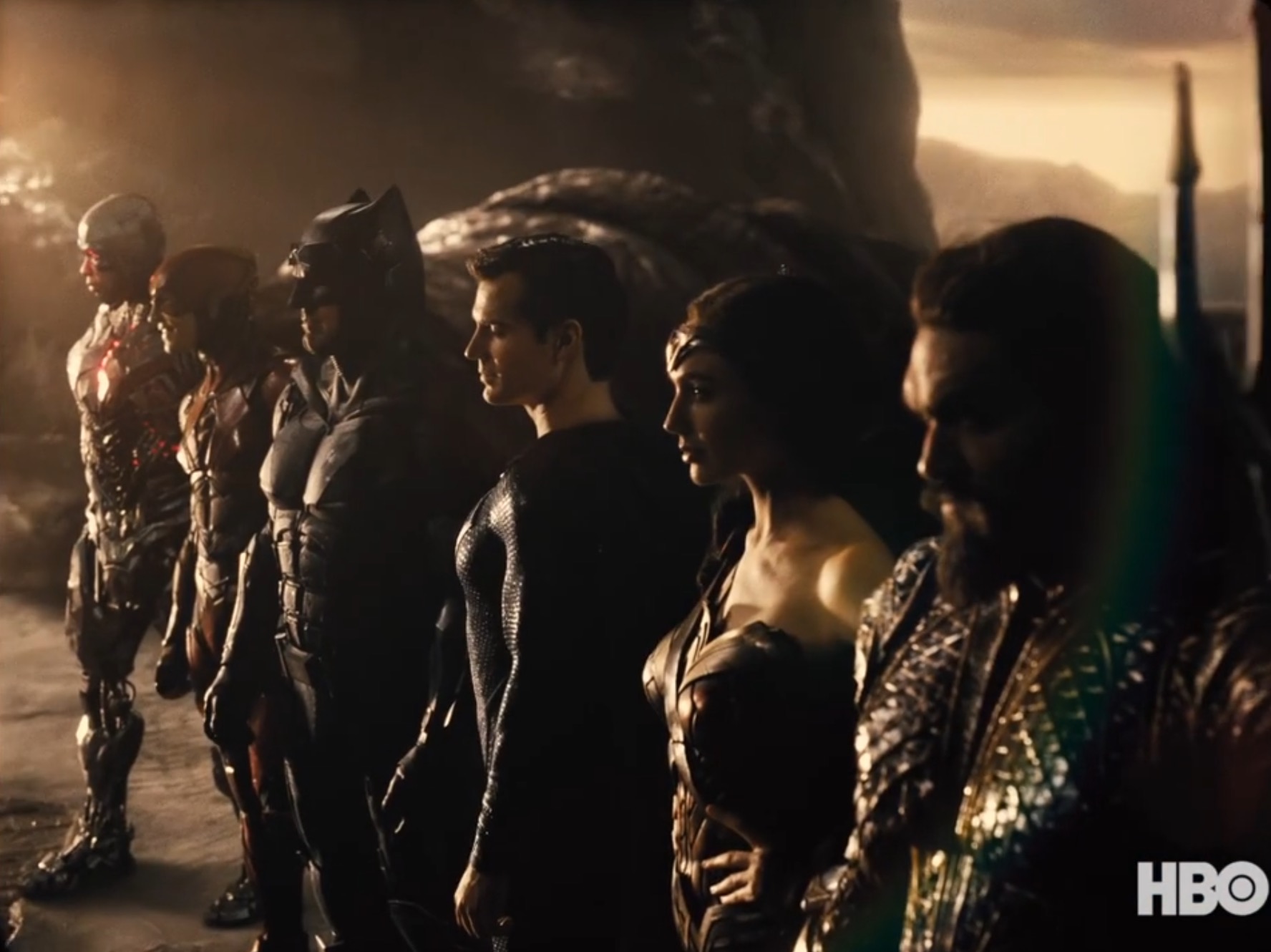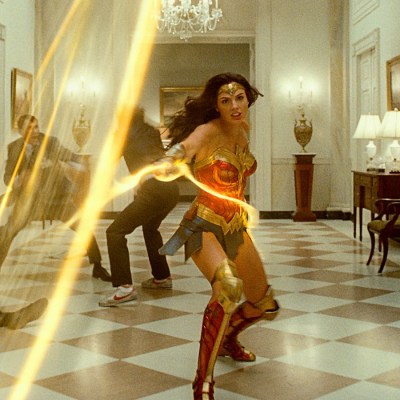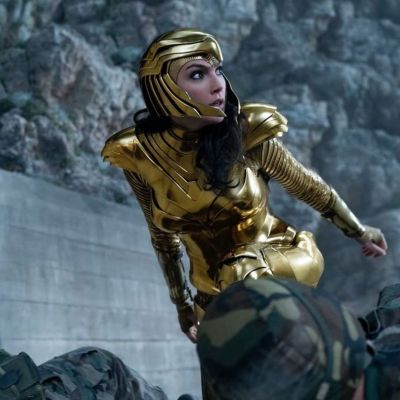This article contains Zack Snyder’s Justice League spoilers. We have a (relatively) spoiler free review here.
Well, they finally released the Snyder Cut! Zack Snyder’s Justice League is now out in the world (and streaming on HBO Max) and it’s four hours of the director’s undiluted, controversial take on the DC Universe. It’s even more packed with DC history than the “official” theatrical release, if you can believe that, and it builds out the world of the DCEU in some new and unexpected ways.
There’s no shortage of DC Comics Easter eggs in Zack Snyder’s Justice League, and even nods to DC movies of the past. It’s a six course meal of a movie that DC superhero fans should savor, because we’re unlikely to ever see anything like this ever again.
We’ve tried to find all the DC references and lore in the film. Here’s what we’ve got so far.
The Story
While the Justice League have been around since 1960 (they first appeared in Brave and the Bold #28) the broad strokes of this movie are based on 2011’s Justice League: Origin (which was adapted as the animated movie, Justice League: War), the comic book story that revamped the team’s initial team-up for a new generation. The villain of the comic was Darkseid not Steppenwolf, but the Parademon hordes, the Mother Boxes, and the tying of Cyborg’s origin to Fourth World technology all come straight out of this story.
Steppenwolf DID show up in a contemporary story as well, though. A visually-similar version of the character appeared in DC’s Earth-2, which indicated that Darkseid’s attack on Earth was one that spanned the multiverse, and his lieutenant Steppenwolf ravaged a different Earth, killing its greatest heroes in the process. So that’s two big comics influences out of the way here.
Throughout this movie, Steppenwolf keeps on trying to bring about “the unity” with the three Mother Boxes, but as far as I know, that has no correlation to anything in the comics. If anything, Steppenwolf’s quest and the movie’s backstory has more in common with the Lord of the Rings saga than anything Jack Kirby did, with magical tech being distributed across the different races of the world to keep it from falling into the wrong hands.
Aquaman
- Of all the characters in this film, Aquaman seems to bear the most of Zack Snyder’s stamp. It’s incredibly visible just in his eyes, which were “humanized” considerably by the time he appeared in his solo movie.
- Snyder’s original vision for Aquaman was clearly something a little grittier than the gleaming underwater fantasy that James Wan brought us. The eerie “hymn” that the women of the village sing to mark Arthur’s departure is a haunting reminder of how these characters are seen in this world.
- As Aquaman returns to Atlantis, we see a familiar octopus. Could this be Topo, comic book octopus sidekick to Arthur and famed for his drum solo skills in the Aquaman movie? I’d like to think it is.
- Willem Dafoe’s Vulko is here, looking a little different and perhaps a bit less kindly than he did in Wan’s film. Interestingly, he refers to Arthur as “the king who would be man,” an inversion on “the man who would be king,” and a shot at Arthur for not taking his rightful place as heir to the throne of Atlantis. For his part, Arthur’s refusal on the grounds that the Atlanteans are a “brutal, petty, superstitious people” also hints at broader visions Snyder had for the character.
Read more
- It’s interesting to note that Mera and other Atlanteans speak with English accents here, where they didn’t in the Aquaman movie. It’s a proud tradition of making alien races speak with an English accent, one perhaps most famous in superhero movies thanks to virtually the entire population of Krypton in Richard Donner’s Superman: The Movie.
- Similarly, Atlanteans don’t speak underwater here as they do in the James Wan film, instead creating bubbles of air in which to communicate like land-dwellers. It’s pretty cool.
- The song that plays when Arthur vanishes into the waves is Nick Cave’s “There is a Kingdom,” and its lyrics are pretty much as on-the-nose as you might expect.
Aquaman spearing two Parademons with his trident reminds me of this moment from Justice League: Origin, as well…

- Is Aquaman the first person to call Bruce “Batman” in the DCEU? In Batman v Superman it was all “the Bat” this and “the Gotham Bat” that.
Speaking of Batman…
Batman
- When we first see Bruce Wayne searching for the mysterious Arthur Curry, he’s riding a jet black horse, which is very similar to the steed he rode in some famous pages of Frank Miller, Klaus Janson, and Lynn Varley’s classic and influential The Dark Knight Returns, a work which has considerable influence on how Batman was portrayed here and in Batman v Superman: Dawn of Justice.

- If you look closely you can see a 201 area code on Bruce Wayne’s business card, which further confirms that Gotham City is on the New Jersey side of the river that separates it from Metropolis.
- This movie, like Batman v Superman before it, reminds us that we’re dealing with a Batman who has been active for 20 years. It’s yet another reminder of the influence of The Dark Knight Returns on the DCEU vision for Batman, depicting him as a much older, more experienced crimefighter.
- Let’s just take a moment to appreciate how good Jeremy Irons is as Alfred Pennyworth. His line about “someone who broods in a cave” is classic Alfred shade (as is the moment later on when he is totally micromanaging how Diana makes tea). See also: Bruce’s joke about how he works for Alfred.
- Bruce tells Alfred that he “made a promise to him [Superman] on his grave.” As we well know with Bruce and his parents, when he swears on someone’s grave, it’s a promise he takes very seriously.
Read more
- We meet Kobna Holdbrook-Smith as Crispus Allen very briefly in Gotham PD HQ talking to JK Simmons’ excellent Jim Gordon. Detective Crispus Allen was a Batman supporting character who played a significant role in the excellent Gotham Central series. While we don’t get any hint of his future here, Allen went on to become the human host of the Spectre after he was murdered by a corrupt colleague.
- Barry asks Bruce incredulously, “you have a satellite?” to which Bruce calmly responds, “I have six.” It feels very much like something Grant Morrison’s Batman would say (he even owns a flying saucer), but it ALSO hints at the fact that for many years, the Justice League operated out of a satellite HQ. Perhaps Bruce would consider moving the team up there in future installments.
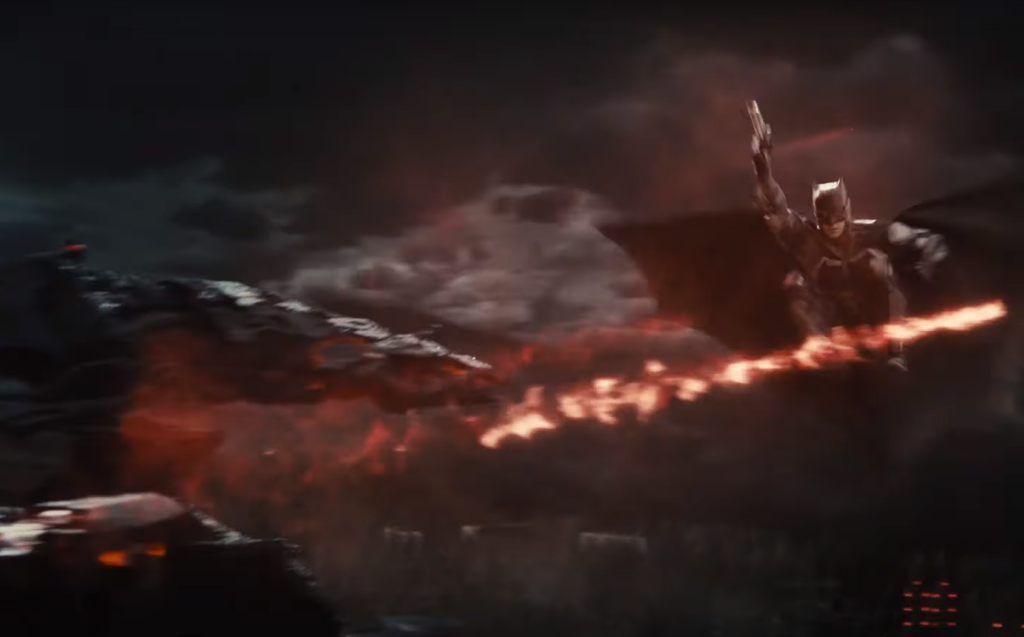
- During the big battle at the end, there’s a terrific shot of Batman that mirrors his first appearance in Detective Comics #27.

- There’s a pretty clear shot of the Bat-tank that is a very direct nod to a panel from Dark Knight Returns.
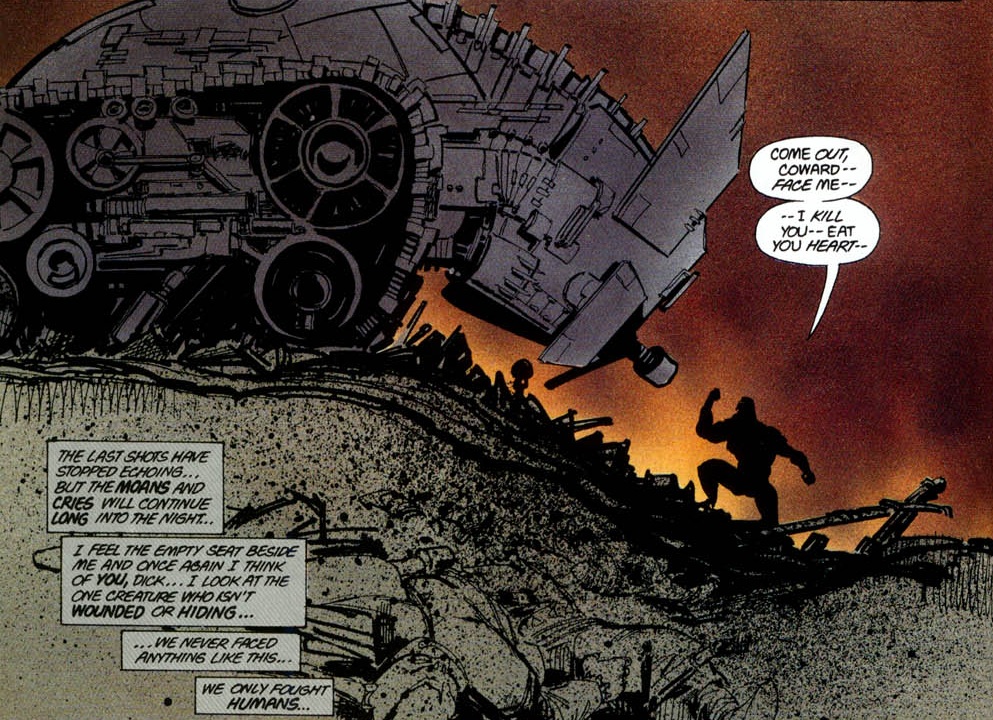
Cyborg
- It seems like all the flashbacks to Vic Stone’s pre-Cyborg college days take place in 2015, so it’s after the events of Man of Steel, but he has only been “Cyborg” for a relatively brief period here.
- Thanks to the backstory in this version of the film, we learn that Vic is already a genius level intellect. Although in the comics it was because Drs Silas and Elinore Stone were already experimenting on their son long before the accident that forced them to turn him into Cyborg.
- Interestingly, the origin story here is neither the classic comics origin nor the New 52 version (surprising, since so much of this film feels inspired by the New 52 Justice League: Origin story). There, it was either an accident with interdimensional energy or the opening of a Mother Box/Boom Tube which virtually destroyed Victor’s body and caused the creation of Cyborg.
- What is the Dean of GCU’s name? It looks like it might be “Dean Stanton” which would be a lovely tribute to actor Harry Dean Stanton (but there’s no DC Comics connection here in that case).
- You may note that the scoreboard for Gotham City University was built by Wayne Enterprises.
- It’s probably a coincidence, but Cyborg financially helps out a “Linda S. Reed.” In the comics Linda Reed was a short-lived Green Arrow character who (along with her twin sister Ramona) went by the uninspiring name of “Girl Archer.”
- Since Vic Stone has traditionally been a Teen Titans character, and he and Barry are by far the youngest members of the League, it makes sense that they would bond. Especially since this version of Barry Allen has more in common with the comic book version of Wally West than anything else, and Wally was a member of the Titans with Vic.
The Flash
- When we first meet Barry Allen he is late to a job interview. This isn’t just a play on “oh, the fastest man alive is actually really slow” or something, Barry’s habitual lateness was baked into the character in his very first appearance back in Showcase #4. Similarly, even his predecessor, Jay Garrick was known for this not terribly charming trait, too.
- Interestingly, Barry’s persona in the DCEU feels much more in common with the Wally West of the DC Animated Universe. He’s the less experienced hero, a kind of point-of-view character, and generally younger and funnier than his teammates. But the more specific Wally reference is his need to consume tremendous quantities of calories to keep going (his “snack hole” crack), something that was unique to Wally among Flashes (but which was also utilized when John Wesley Shipp played Barry on the 1990 The Flash TV series).
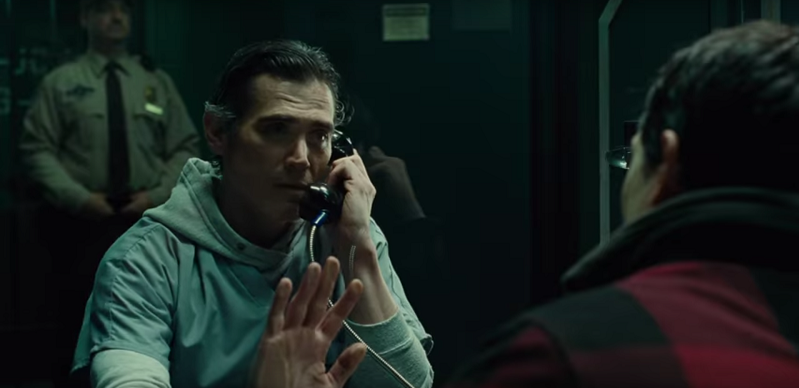
- That’s Billy Crudup as Henry Allen in jail (who sadly won’t be reprising his role in Andy Muschietti’s The Flash movie) The whole “hands on the glass” thing was done quite a bit between the TV versions of these characters, played by Grant Gustin and the great John Wesley Shipp. Henry’s line to Barry that he should “make your own future” would seem to foreshadow the events of Flashpoint, as well.
But there’s one other similarity to the TV show worth pointing out…
- Barry notes to Bruce that he is fluent in “gorilla sign language,” which could come in handy down the road should he encounter a race of superintelligent gorillas who have started their own civilization or something like that.
- Is Barry wearing a “Black Freighter” t-shirt? As in the pirate story that is woven through the Watchmen comics? You don’t need me to remind you that Zack Snyder also directed a Watchmen movie, right?
- If you look at Barry’s desk, there’s a photo of Nikola Tesla there, which makes sense given Flash’s whole aesthetic.
- One fun thing about Barry’s personal HQ: If you look carefully on one of the TVs, you can spot that he’s a Rick and Morty fan, and a particular season two episode, which involves a chemically-enhanced Summer and Rick beating the crap out of unsavory types like Nazis, is playing in the background.
- It’s interesting to note that Barry is only now just on the path to becoming a police scientist, rather than already having been driven to do so. It’s almost like his time with the Justice League inspires him to do more with his professional life, as well.
Read more
- It’s interesting that the Barry Allen of the DCEU is Jewish, if only because we’ve never had any hint of Flash’s faith (or lack thereof) in the comics or on the TV show. The closest Barry Allen has to any kind of religious or ethnic identity has always been “midwestern.” Brian Cronin at CBR thinks this could be a reference to a throwaway line from a late ’80s DC story, but I don’t necessarily think that’s considered canon. I’m open to corrections, though!
Iris West
- We see the first meeting between Barry Allen and Iris West here. I don’t know the exact make and model of the vintage convertible that Iris is driving (if anyone does, please give us a shout in the comments or on Twitter), but it feels like it COULD be from the year 1956, when Showcase #4 was published. Similarly, the excellent and underrated The Flash TV series from the 1990s used to populate the streets of its version of Central City with vintage cars to give it a “timeless” feel.
- Speaking of Showcase #4, the fact that hot dogs are among the things kind of hovering in midair thanks to Barry moving at super speed is another nod to the character’s first appearance, when one of Barry’s first super speed acts was to catch a spilled tray of food in a diner in mid-air before the waitress knew what had happened.

- What’s the brand of fast food the truck driver is eating? I can’t quite make it out. It would be cool if it was a Big Belly Burger with a Soder Cola, but I think it might just be something lame like “Burger Shop.” Help me out, folks!
- The truck that nearly kills Iris is for a company called Gard’ner Fox, a reference to classic Flash writer/co-creator Gardener Fox.
- You can see a newspaper box for The Central City Tribune, which hints at the fact that Iris West is a journalist in the comics.
Superman
- Martha’s dog’s name is Rusty, which I THINK is a reference to a briefly glimpsed pooch in Richard Donner’s Superman: The Movie. But I can’t fully confirm that as of this writing.
- Lois Lane’s depression and loneliness is soundtracked, appropriately enough, to “Distant Sky” by Nick Cave and the Bad Seeds (Mr. Snyder seems to love the work of Nick Cave), which features lyrics like “They told us our gods would outlive us,” but there’s lots here that mirrors the journey of these heroes in the film.
- The Daily Planet’s slogan in the DCEU is “reporting on the planet, daily” which seems a little on-the-nose to me, but whatever. It’s had several in the comics, but in Richard Donner’s Superman it was “Metropolis’ Greatest Newspaper.”
- When the Motherbox generates the image of Superman flying, it’s a classic Superman pose this is. This is a really cool shot, and looks like a Curt Swan/Murphy Anderson drawing of the Man of Steel come to life.
- During the return to the Kryptonian ship that served as the de facto Fortress of Solitude in Man of Steel (and which gives Supes his black costume here), we can spot the open pod that launched so many fan theories in 2013. A possibly no-longer-canon Man of Steel prequel comic that was nonetheless written by David Goyer implied that it was Kara Zor-El who was in that pod, and who has roamed the DCEU undiscovered thus far.
- You can hear moments of Hans Zimmer’s truly excellent Man of Steel score at key Superman moments throughout the film, too.
- Clark Kent was buried in a conservative dark blue business suit, with a red tie, and black shoes. That is the exact outfit that the comic book version of Clark Kent wore in virtually every single comic book appearance from roughly 1938 until 1986. Henry Cavill’s Clark was a little more fashionable in life, but not in death.
Read more
- When Superman wakes up, well, it’s not pretty. This scene serves two purposes, though. For one thing, it demonstrates how he is more powerful than the entire team combined, lest anyone think that Superman is lame. But his disorientation and raw fury are a slight nod to how in the comics and cartoons, at several points, Superman has been manipulated by Darkseid. While that doesn’t quite happen here, the role of Fourth World technology in his resurrection feels like it’s not a coincidence.
- Clark “returning” to himself in the field in front of his Smallville home and being greeted by Martha Kent feels like an inversion of Clark leaving home in Superman: The Movie and bidding his mother farewell. He’s wearing a similar flannel shirt in both scenes, too.
- As Clark completes his journey and “returns” to being Superman, complete with the cool new costume (more on that in a second), we hear the voices of BOTH his fathers, both Jor-El and Jonathan Kent. It’s yet another nod to Richard Donner’s Superman, when Kal-El was guided by the voice and spirit of his Kryptonian father when he first wore the suit. And, of course, his takeoff here mirrors his first flight in Man of Steel, completing his “rebirth.”
- The black and silver Superman suit was a fixture of Reign of the Supermen, the story that brought the recently deceased Man of Steel back to life. In the comics, it was a kind of regeneration suit, meant to help harness solar radiation for Superman’s cells. It’s not clear if it is meant to serve that purpose here, since (as we see when he kicks the entire League’s ass) he was already at full physical (if not mental) power upon his resurrection. It’s been done several times in live action too, but it has never looked as good as it does here.
- Amusing detail about the Kent Farm being foreclosed on…there’s already some awful suburban McMansion built right across the road.
- Marc McClure who played Jimmy Olsen in the Donner Superman films played an Iron Heights prison guard in the theatrical cut of the film, but here he is the cop guarding the Superman memorial in Metropolis.
- And the final true shot we see of Superman in the film, with Clark Kent becoming aware of trouble and doing the classic “shirt rip” is another iconic moment from throughout the character’s history, although it’s never better than it is in Superman: The Movie right before the big helicopter rescue. It’s worth noting that in the theatrical cut, Supes was back in the red and blue, while here he has chosen to stay in the black and silver.
Wonder Woman
- One of the big takeaways from Wonder Woman’s intro sequence is that even mundane villains in the DCEU are cool, stylish, dangerous, and they don’t think small. These guys are the face of a mysterious organization who want to “turn back the clock” but I have yet to find a suitable DC Comics parallel to them.
- Of course, the statue we see Wonder Woman standing on is Justice herself.
- Diana’s white dress while she’s working on restoring the statue feels vaguely reminiscent of her “mod years” in the late 1960s, where she briefly ditched her primary colored costume to fight in something a little more practical.
Read more
- Wonder Woman wearing an appropriately stylish black getup when visiting Bruce in the cave kind of reminds me of Wonder Girl Donna Troy’s star-spangled black outfit that she wore for a little while…but that’s probably just a coincidence.
- Diana tells Bruce that she “once knew a man who would have loved to fly it” regarding Bruce’s flying troop transport for the League. She is, of course, referring to Steve Trevor, but this line takes on a little bit of extra weight after we see Steve flying more modern aircraft in Wonder Woman 1984.
- At one point in the film, Diana hints that Atlantis and Themyscira had been at war at one point in the past. This has been teased in the comics several times and came to a head in the Flashpoint comics.
- There’s a cool moment when Steppenwolf tells Wonder Woman that she has “the blood of the old gods” in her veins. When Jack Kirby created the New Gods and the Fourth World, he was still working for Marvel. The original plan was for the Asgard of Marvel’s Thor comics to undergo a Ragnarok, everyone would die, and in its place would be these New Gods. Obviously that didn’t happen, and the concepts ended up at DC. But that one line, tying Diana’s Greek mythology roots directly to the cosmic New Gods of the DCEU, is surprisingly in keeping with Kirby’s original intention.
Ryan Choi
- We get another hero snuck into the mix in this movie, in the form of STAR Labs’ Ryan Choi (played by Zheng Kai). While he doesn’t suit up in this film, Choi was the inheritor of Ray Palmer’s mantle as the shrinking superhero, the Atom.
- By the end of the film, Choi is given the title of head of nanotechnology for STAR Labs, further setting up his future as a hero.
Green Lantern
While no Green Lantern remains alive for long in this film, there are plenty of references to the Green Lantern Corps throughout…
- Steppenwolf promises that there are “no protectors, no Lanterns, no Kryptonian” guarding Earth this time, which is pretty self-explanatory.
- This member of the Green Lantern Corps we see fall in battle during the flashback sequence is Yalan Gur, a character who has only made a handful of appearances in the comics. Gur was indeed the Green Lantern of space sector 2814 (that includes Earth) around the time this battle would have taken place. In the comics, Gur was corrupted by his own power and turned on the humans of Earth, but he clearly didn’t get that chance in the movie, as he was killed by Darkseid in the flashback.
- During the vision of the future where Darkseid has gained control of the Anti-Life Equation, another dead Green Lantern can be spotted amongst the rubble of a ruined city. That would be of Green Lantern Corps drill sergeant and fan favorite, Kilowog. This is Kilowog’s second live action appearance, if you count 2011’s not great Green Lantern movie with Ryan Reynolds.
Darkseid
- Steppenwolf tells the Amazons that he “has come to enlighten you to The Great Darkness.” The Great Darkness is more than just a reference to Darkseid himself and his entire philosophy, but is also a reference to what is perhaps the ultimate Legion of Super-Heroes story, The Great Darkness Saga, by Paul Levitz and Keith Giffen, which saw a long dormant Darkseid return to life to terrorize the galaxy a thousand years from now.
- When Darkseid strikes the surface of the Earth with his axe, it creates the kind of hellish firepits that his homeworld of Apokalips is famous for.
- Darkseid taking on the literal “old gods” of Earth including Zeus, Ares, Apollo, and Poseidon is a fun contrast with the fact that he is part of DC’s “New Gods” mythology.
- Darkseid is searching for the Anti-Life Equation, which we wrote more about here.
- During Darkseid’s “vision” of the universe once he has obtained the Anti-Life Equation, we can see Superman holding a charred corpse, which is presumably the body of Lois Lane. This apparently sets him up for corruption by Darkseid, and helps bring about the “Knightmare” vision from Batman v Superman, which is once again glimpsed at the end of this film.
- The third figure we see on Apokalips with Darkseid and Desaad appears to be Granny Goodness, the chief of the armies of Apokalips (and the one who trained/traumatized DC heroes Mister Miracle and Big Barda).
Parademons
The weird insectoid drones making everyone’s lives miserable are Parademons, the foot soldiers of the planet Apokolips, a hellish world which lives in opposition to New Genesis, the home of the New Gods and Forever People. All of this great stuff was created by the brilliant Jack Kirby, by the way. Steppenwolf (more on him in a minute) and the Parademons are trying to collect three Mother Boxes left on Earth.
What is a Mother Box?
- The Mother Box is the unifying piece of technology of Jack Kirby’s Fourth World epic. Think of a Mother Box as an alien smartphone that can do anything from heal the injured to teleport you across time and space. It’s pretty cool hearing their trademark “ping. ping. ping.” sound for real.
- Mother Boxes are often used to call down Boom Tubes, the preferred method of transport of the New Gods and their friends and foes. We see them deployed quite a bit throughout this movie, obviously. Super Powers fans of the 1980s may remember that on Super Friends: Galactic Guardians, boom tubes were referred to as star gates.
- It’s POSSIBLE that the knights burying the Mother Box are meant to be King Arthur and his crew, while the one with the horns could be Sir Bors. They relatively recently appeared in Demon Knights, but they were best in Seven Soldiers of Victory, where the Knights of the Round Table fought an invasion from evil Faeries and lost, only to have Sir Ystina, the Shining Knight, help save the world in the present day. Honestly, that sounds like it would be pretty up Zack Snyder’s alley too, now that we think about it.
- Mother Box is cataloged as “unknown object 61982” after it has been discovered in the modern world. So far, I haven’t been able to find any DC Comics or DCEU significance to that number.
DeSaad
- DeSaad is Darkseid’s chief advisor and torturer-in-chief (hence the name). Like all the other cool Fourth World stuff in this movie, he was created solely by the legendary Jack Kirby. He first appeared in Forever People #2 in 1971.
- It’s kind of cool that the nameless “Motherbox priestesses” kind of look like DeSaad, too.
Steppenwolf
- Steppenwolf is the first Jack Kirby creation to show up in a DC superhero movie (for comparison, nearly the entire Marvel Cinematic Universe owes its entire existence to Jack Kirby). They don’t really give us much to go on with Steppenwolf in this flick, but to be fair, he wasn’t one of Kirby’s most inspired creations and it’s not like he has the longest comic book history. In the comics, Steppenwolf was Darkseid’s uncle, and responsible for the war between Apokolips and New Genesis, but here he appears to be his nephew instead.
- In a lot of ways, particularly his appearance, this version of Steppenwolf seems to owe more to his appearance in DC’s New 52 version of the Earth-2 comics than he does any of Kirby’s vision.
- The weird little spider-y device that Steppenwolf uses to get information on people looks a lot like Starro, the first villain that the Justice League ever fought in the comics, right down to the way it attaches to people’s faces.
Martian Manhunter
- We get our first long-promised revelation of Martian Manhunter in the film, who, as it turns out, had been masquerading as Harry Lennix’s General Swanwick the entire time.
- Martian Manhunter finally revealing himself to Bruce at the end kind of completes Bruce’s journey from vaguely fascist xenophobe in Batman v Superman to someone far more heroic.
- Martian Manhunter says he has “gone by many names” but doesn’t mention any of them. It doesn’t make sense why he wouldn’t have introduced himself as J’onn J’onnz (his Martian name). Other names he has gone by include Detective John Jones (not in the movies), and as we’ve seen in this very film, General Swanwick.
- While we don’t get to see Martian Manhunter officially join the Justice League here, his presence in the film kind of completes the “unite the seven” tease that dates back to Batman v Superman. Martian Manhunter has always been depicted as a founding member of the team, both in comics and in the excellent Justice League animated series.
Deathstroke
We get a LITTLE more of Joe Manganiello’s Slade Wilson in this movie than we did in the theatrical cut…
- In the theatrical version, Lex had summoned Deathstroke in order to start assembling a Legion of Doom-esque team of supervillains. But here it’s to give him Batman’s true identity. Apparently this would have helped set Deathstroke up as the villain of the Ben Affleck-led Batman solo movie, which would have featured Deathstroke dismantling Bruce Wayne’s life, Daredevil: Born Again style.
- We see Deathstroke again during the epilogue where Slade (who is more of an antihero in the comics) has joined Batman’s ragtag group of freedom fighters against Darkseid and the forces of Apokalips.
Speaking of that epilogue…
Joker
No, your eyes do not deceive you, that is indeed Jared Leto returning as the Joker, marking his first appearance in the role since his controversial turn as the character in the Suicide Squad movie.
- So…it appears that the “Knightmare” sequence in Batman v Superman wasn’t a vision of this movie after all, but rather for the Justice League 2 we’ll never see. And it’s up to Jared Leto’s Joker of all characters to explain this to us once and for all.
- It seems that in a not-too-distant future, Darkseid’s armies have indeed come to Earth, and he is either in search of or has claimed the Anti-Life Equation, having murdered Lois Lane, turned Superman to evil (god, why does Zack Snyder love this idea so much), leaving a ragtag group of heroes and villains to try and set things right.
- The death of Lois Lane at the hands of a villain turning Superman into a maniac feels quite a bit like the storyline of the Injustice video game.
- Joker makes several allusions to having murdered Robin, which in the comics would be Jason Todd, although Snyder has hinted before that the dead Robin in question was actually Dick Grayson (hence, no Nightwing in the DCEU).
- The notion of Batman and Joker teaming up in any capacity isn’t one with a whole lot of weight in the comics, but them coming together in a post-apocalyptic landscape with Joker acting as a kind of truth-teller for Batman is faintly reminiscent of Scott Snyder and Greg Capullo’s Batman: Last Knight on Earth.
- Joker’s hints that Batman needs to die in order to set things right are reminiscent of Grant Morrison’s superb Final Crisis.
Lex Luthor
- Lex Luthor’s escape from Arkham Asylum (side note, it has always rubbed me the wrong way that they keep Lex at Arkham…that isn’t where you put Lex Luthor) with a fakeout vaguely reminds me of how he escaped from prison in Superman II, which involved using a hologram to fake out the guard. The guard’s response to “Lex” not doing what he’s supposed to here is similar, too.
- When we finally see Lex for real, it’s on the yacht, and his loud outfit is more than a little bit reminiscent of how Gene Hackman’s Luthor dressed as Lex in the Superman movies of the 1970s and 1980s.
Miscellaneous Stuff
- Bruce returns to the ruins of Wayne Manor which he intends to convert into a headquarters for the newly formed Justice League. But placing a roundtable in a mansion has a little bit more of a Justice Society of America vibe to it…but that’s just a coincidence. However, we’ll be meeting the Justice Society in the upcoming Black Adam movie.
- There’s a headline in The Daily Planet that says “Security Bank of Manhattan Sets New Architect.” No, this isn’t a John Stewart Green Lantern reference. Instead, it’s a nod from Snyder to the character of Howard Roark, the protagonist of Ayn Rand’s The Fountainhead, a favorite of the director’s and a project he once hoped to adapt into film. In that book, Roark is an architect who is commissioned to work on the “Security Bank of Manhattan.” Draw your own conclusions about Snyder’s love for this book and Rand’s work, however.
- That isn’t the only Ayn Rand reference in the film, either. The fishing boat that Aquaman rescues is called the Cortlandt, a reference to a housing development in The Fountainhead.
- The place where Lois gets her coffee is “Fred and Ginger Coffee” as in Fred Astaire and Ginger Rogers. Also, if you look really closely in the window of the coffee shop as she leaves, there’s a man at a table wearing a vest. I’m not 100% sure, but I THINK this is Zack Snyder giving himself a Hitchcock-esque cameo in the film.
- The STAR Labs janitor who goes missing/gets eaten by Parademons is apparently named Howie Jensen. Whenever there’s a janitor in a top secret area working with alien tech in the DC Universe, my mind immediately goes to Superman villain, the Parasite. The most famous version of the Parasite was Rudy Jones, a STAR Labs janitor who ended up wallowing in some toxic waste (perhaps coincidentally because Darkseid manipulated him into it). Anyway, this isn’t Rudy Jones, so it can’t be the Parasite right? Well…mostly. There was a previous Parasite names Raymond Jensen…which seems to be our poor, doomed, pal Howie’s name in this.
- When Bruce leaves Barry’s lair to drive to the Central City Airport, there’s an AFSP billboard that says “You are not alone,” another nice tribute to Snyder’s work for that foundation and to raise awareness for suicide prevention.
- During Darkseid’s vision of the future he wants, there’s a ruined Hall of Justice, the Justice League headquarters first made famous on the Super Friends cartoon and which, in more recent years, has become a fixture of the comics.
- The pregnancy test in Lois’ nightstand is named, we kid you not, Force Majeure.
Spot anything we missed? Let us know in the comments!
